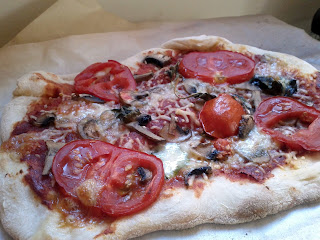Back to non-failing bread, and it feels pretty good. This is after my no-rise bagels (dead yeast) and my no-rise mini baguettes (too much salt). Now, there is definitely one are where this recipe could be improved and a large avenue for experimentation. But - still good, still workable. Not a complete failure. The recipe is based off of the 50% whole wheat rustic from Artisan Breads Everyday, but contains a few tweaks. The goal was to create something like a pain au levain, without all that starter business. (Not that I'm against starters; one should be starting up this weekend).
It wasn't perfect, but it was close. The bread was a bit too much like a honey whole-wheat sandwich loaf than I would have liked. That is, it was soft but not airy, and excelled at soaking up honey (and, presumably, pbj if I had it handy). The spelt gave it a nice nutty flavor; I don't think the sesame seeds did anything besides poke out of the crust like sailors bobbing in the waters near a shipwreck. The biggest issue was definitely the texture, which was caused by my inclusion of olive oil in the recipe. I would cut it in half as an experiment; removing it entirely would likely prove drastically dry. Walnuts would also have been a great addition to this loaf, though I did not have them handy.
_______________o _______________
Sesame Spelt Loaf
Makes 1 loaf
225g water
130g bread flour
130g whole wheat flour
20g spelt flour
20g sesame seeds
12g olive oil (halve this for a airier, less moist loaf)
5g salt
3g instant yeast
At least a night before you want to bake the bread, combine the dry ingredients in a bowl and mix. Add in the water and olive oil, and stir with a wooden spoon for 5 minutes. Let rest for 5 minutes to hydrate things, then stretch and fold 4 times with a 10 minute break between each. Place in a clean bowl, cover tightly, and place it in the fridge.
The day of baking remove the dough from the fridge 1.5 hours before you wish to put it in the oven and shape it however you like (it might actually make great rolls as-is, without cutting down the olive oil). Place it on a parchment-lined pan, cover it, and let it sit until baking time. Preheat oven to 500, put the bread in, lower to 450, and cook for ~35 minutes. Check and rotate the loaf at the 15 minute mark. It is done when it sounds hollow and the top is very hard.










